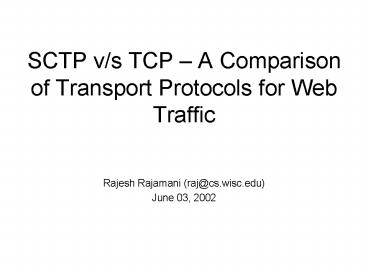SCTP v/s TCP PowerPoint PPT Presentation
Title: SCTP v/s TCP
1
SCTP v/s TCP A Comparison of Transport
Protocols for Web Traffic
- Rajesh Rajamani (raj_at_cs.wisc.edu)
- June 03, 2002
2
Outline
- Motivation
- Introduction to SCTP
- Server Architecture
- Experimental Design
- Parameters
- Results
- Conclusion
3
Motivation
- Many applications need reliable message delivery
they do so by delineating a TCP stream - TCP provides both strict-ordering and reliability
many applications may not need both
4
Motivation (contd)
- HTTP is one such application
- While transferring multiple embedded files we
only want - Reliable file transfer for each file
- Partial ordering for the packets of each file but
not total ordering amongst all the packets - TCP provides more than this (but overhead?)
- SCTP may help (how? later)
5
What is SCTP?
- Originally designed to support PSTN signaling
messages over IP Networks - It is a reliable transport protocol operating on
top of a connectionless packet network such as IP
(same level as TCP)
6
Major Differences from TCP
- SCTP is message oriented
- SCTP has the concept of an association instead of
a connection - Each association can have multiple streams
- SCTP separates reliable transfer of datagrams
from the delivery mechanism - SCTP supports multihoming
- Connection Setup
7
Packet Format
8
Similarities to TCP
- Similar Flow Control and Congestion Control
Strategies employed - Slow Start and Congestion Avoidance phases
- Selective Acknowledgement
- Fast Retransmit
- Slight differences for supporting multihoming
- Known to co-exist well with TCP
9
HTTP Server Architecture
Single File Transfer ( Both TCP and SCTP are
similar)
Client
Server
Child process
10
HTTP Server Architecture
Multiple File Transfer (Embedded files) - TCP
Client
Server
Child process
11
HTTP Server Architecture
Multiple Files Transfer (Embedded Files) - SCTP
Client
Server
Child process
12
The Scientific Method
- Observation HTTP does not require strict-order
of delivery, when fetching embedded links. Also,
HTTP is message-oriented protocol - Hypothesis and Predictions SCTP provides
partially ordered delivery and guarantees
reliability. This can reduce user-perceived
latency and improve throughput
13
Latency
Server
Client
1
3
2
1
3
2
1
3
2
1
File 1
File 2
File 3
TCP Receive buffer in kernel
14
Latency
Server
Client
1
3
2
1
3
2
1
3
2
1
File 1
File 2
File 3
SCTP Receive buffer in kernel
15
Throughput
Server
Client
3
2
1
3
2
3
2
1
3
2
1
1
File 2
File 3
TCP Receive buffer in kernel
TCP Send buffer in kernel
16
Throughput
Server
Client
3
3
2
2
3
2
1
3
2
1
1
1
File 2
File 3
SCTP Receive buffer in kernel
SCTP Receive buffer in kernel
17
Experimental Design
- FreeBSD kernel implementation of SCTP and TCP
Reno - HTTP 1.1 Server and Client
- Similar implementations for TCP/SCTP
- Dummynet to simulate interconnection network
18
Our setup
Server
Client
Dummynet configured with different b/w, delay and
loss characteristics
19
Parameters
- We observe latencies for single file and multiple
file transfers by varying the following
parameters - Loss rate (0, 1, 2, 5, 8, 10, 15, 20,
25) - Link Bandwidth (40kbps, 400kbps, 3mbps,10mbps)
- We keep Latency constant (80ms)
20
Results
21
Results
22
Results
23
Possible reasons
- No TCP SACK option in FreeBSD. SCTP uses SACK
Not apples to apples comparison - Better rwnd management and smoother handling of
rwnd and cwnd. - Mark Allmans 4MTU burst limit on all sends
enforced in SCTP. TCP overshoots and overruns
peer, resulting in a retransmit
24
Results - Latency
Protocol Loss File 1 File 2 File 3 File 4 File 5 File 6 File 7 File 8
TCP 0 0.679 0.768 3.873 3.910 3.942 4.243 4.273 4.708
SCTP 0 0.802 0.888 4.468 4.507 4.607 4.834 4.878 4.887
TCP 1 4.930 5.595 29.598 31.047 31.924 33.460 34.333 38.222
SCTP 1 4.299 4.775 24.132 24.536 25.106 26.678 27.143 29.628
TCP 2 5.983 6.725 35.361 37.232 38.509 40.681 42.568 45.179
SCTP 2 5.506 6.098 31.539 32.164 32.692 33.117 33.981 41.551
Latency of each file in multiple file transfer
test, B/w10Mbps. Values in red are higher.
All times are in seconds
25
Results
26
About Errors
Loss in this direction 1
Loss in this direction 1
27
Conclusions
- The current SCTP implementation performs almost
as well as TCP when there are no losses
However, there is an extra overhead in sending
messages instead of just a stream of bytes - SCTP seems to perform better in the presence of
losses, because it does not enforce strictly
ordered delivery - More graphs available at http//www.cs.wisc.edu/r
aj/sctp
28
Implications
- SCTP can be a viable transport protocol for HTTP
traffic, because - It helps reduce user-perceived latency and also
improves throughput - Uses a 4-way handshake and also uses an encrypted
cookie, which offer better protection against SYN
floods and DoS attacks - Multihoming feature can be exploited to
transparently allow mobile users to switch
between networks
29
Questions?
30
References
- CT90 D. Clark and D. Tennenhouse, Architectural
Consideration for a New Generation of Protocols,
In Proc. of ACM SIGCOMM '90. - RFC 2960 (http//www.rfc-editor.org)
- http//tdrwww.exp-math.uni-essen.de/pages/forschun
g/sctp_fb/ - JST 2000 A. Jungmaier, et. al, Performance
Evaluation of the Stream Control Transmission
Protocol, In Proc. of the IEEE conference on High
Performance Switching and Routing, June 2000.

